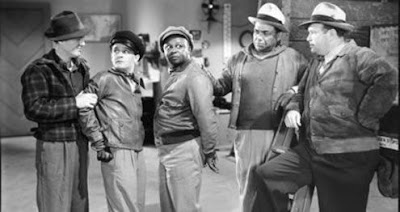Danger on the Air (1938)
Starring: Nan Grey, Donald Woods, Richard 'Skeets' Gallagher, Peter Lind Hayes, Lee J. Cobb, Berton Churchill, and Jeff Prouty
Director: Otis Garrett
Rating: Six of Ten Stars
When a radio network's biggest, and most obnoxious, sponsor dies under mysterious circumstances, an ad executive (Grey) and sound engineer (Woods) turn amateur detectives to unravel the mystery and bring the murderer to justice.
On the one hand, "Danger on the Air" feels as light-weight as the balloons floating about the radio station throughout this picture. On the other hand, it feels like it's trying to do too much in its short running time (70 minutes), because it is crammed full of characters, nearly every one of which has a reason for wanting the murder victim dead.
The airy, light feeling comes from the snappy, well-crafted dialogue, of which not a single line or word is without reason--either to advance the plot or to provide characterization. The great interplay that Nan Grey has with just about ever actor she shares a scene with also adds to the film's sense of breeziness. This is especially true for scenes with co-star Donald Woods and the soon-to-be murdered Berton Churchill.
Speaking of Berton Churchill and Nan Grey, they both play characters that I think go a long way to making this movie appeal to modern audiences. Churchill's character of Cesar Cluck is a lecherous, self-promoting businessman who uses any and all means available to crush his competition and forces himself upon every pretty woman he meets because he feels it's his right. Meanwhile, Nan Grey's character, Christina McCorkle is an independent-minded professional woman in charge of her own ad agency who takes no guff from anyone; she may be partners with her brother in the venture, but it's clear who's in charge. When Cluck turns on the "charm" and tries to sexually assault her, she treats him like Harvey Weinstein should have been treated by his victims--she decks him with a sold punch to face. The men in the movie, who have all been kowtowing to Cluck cheer for her actions. Grey's character, and almost every action she takes, is one that should appeal to modern viewers and is as big a part of making this movie as enjoyable as it is as Grey's bright presence on the screen.
Unfortunately, for all the good it has going for it, the movie suffers from trying to do too much in a short running time. It is crammed full of too many characters, each of which get at least a line or two, each of which is referenced by other characters repeatedly, and each of which has a motive for killing the murder victim. Unfortunately, most them are middle-aged men in dark suits, so even the most attentive viewer will had a hard time telling who's who. What's worse, in the end, because of the abundance of characters who all blend together, the stereotypical "gather all the suspects for the big reveal" just adds more confusion to the overall storyline when the killer is ultimately revealed. Although a foundation for the motive is well established, it still feels like the solution comes out of left field.
Usually, I find myself needing the structure of the mystery and the interplay between actors to be of almost equal importance in films of this kind. In this case, however, I found the leads to be so strong--and Grey in particular--that they more than made up for the deficiencies elsewhere. I don't recall seeing films with Woods before, and I've never been as impressed with Grey as I was here (heck, the only other place I remember her from is "Daughter of Dracula", although I am fairly certain she's been in other films I've watched and written about). I will have to seek out more movies with both in the future to see if they shine the way they did here.






































.jpg)






.jpg)
